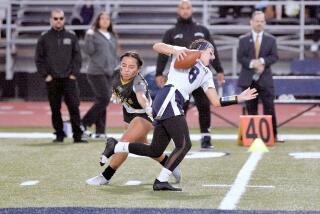TRANSIT UPDATE : A Status Report on Valley Transportation
- Share via
SLOW TRAFFIC
If it seems to take longer to get where you’re going, it does. Congestion has reduced speed on the freeways--in some places a lot, in some a little. Examples from the average morning commute:
* SPEED: Simi Valley Freeway, Topanga Canyon Blvd. to San Diego Freeway
1980: 49 m.p.h.
1990: 28 m.p.h.
* DRIVING TIME: Ventura Freeway, Calabasas to the Civic Center
1980: 50 minutes
1990: 56 minutes
RAIL RELIEF
Plans and hopes for getting cars off the roads
* METRO RAIL--Construction has begun on $1.1 billion extension of the subway from Hollywood to North Hollywood. The 6.3-mile line is to be running by 2001. A House of Representatives committee has approved spending $695 million on the extension.
Disagreement persists on extending Metro Rail to Woodland Hills. In May the county Transportation Commission delayed the target completion date till 2024. It had been set for 2008 to 2019, depending on the success of future bond issues to finance it. There is no definite source of money for the extension.
* COMMUTER RAIL--Two commuter trains through the Valley are scheduled to be running by October, 1992. One route will start in Moorpark, the other in Santa Clarita. Both will terminate downtown at Union Station.
The 47-mile Moorpark line is to include four morning eastbound trains and four evening westbound trains. The 35-mile Santa Clarita line will have three daily round-trips. The seven lines will carry 8,400 passengers daily, a fraction of the 300,000 who will ride the Metro Rail downtown-to-North Hollywood route.
* HIGH SPEED TRAIN--County transportation officials are soliciting bids for construction of a high-speed train line between Los Angeles International Airport and Palmdale. The trains would bo up to 100 m.p.h. on a 71-mile route along Interstate 405, Interstate 5 and the Antelope Valley Freeway. The contract will be awarded in October, 1992.
The line would be privately built but eventually could be publicly operated. The question of financing remains open. Last year a consortium that proposed a $1 billion LAX-to-Palmdale train line using magnetic-levitation technology said it would require public money to operate, due to overly optimistic ridership estimates.
* MONORAIL----An elevated system would run 16.5 milles along the Ventura Freeway from Universal City to Warner Center. Its most forceful advocate, County Supervisor Mike Antonovich, says it is a cheaper alternative to Metro Rail.
The idea got a boost in June, 1990, when it was backed by 48% of Valley residents in a county-sponsored advisory referendum. However, it is opposed by politically influential Metro Rail advocates and homeowners along freeway corridor, who say it would be noisy and ugly.
ROAD RELIEF
Uncorking the bottlenecks
* FREEWAY WIDENINGS--Caltrans is nearing the end of a 2 1/2-year, $76 million project to widen the Ventura Freeway, one of nation’s busiest. Workers are adding a fifth lane in each direction between Calabasas and the intersection of the Ventura and Hollywood freeways, and a sixth eastbound lane between Hayvenhurst Avenue and Interstate 405. The project is to be completed by March or April.
Caltrans also has begun design work on a $39.4 million widening project on the Simi Valley Freeway. It will include a high-occupancy-vehicle lane. Eastbound, the road will be expanded to four from three lanes between Balboa Boulebvard and the Ventura County line. Westbound, a fourth lane will added between Balboa and Topanga Canyon Boulevard.
* BUS ROUTES--Transit officials have launched a study to determine if Valley bus routes should be expanded or altered. About 250,000 people ride Rapid Transit District buses daily in the Valley on 50 routes. After discussions with Valley political and business leaders, RTD decided to reexamine its route pattern. A study is being conducted by RTD, the Los Angeles County Transportation Commission and the cities of Los Angeles, San Fernando, Burbank and Glendale.
* SYNCHRONIZED SIGNALS--At cost of nearly $21 million, city traffic engineers are installing computerized traffic signals in the car-clogged southern Valley. The system already operates along Ventura Boulevard. It is expected to be fully working by February.
Traffic authorities say it cuts delays as much as 20%. It will affect 320 intersections in area bounded by Ventura Boulevard on the south, Victory Boulevard on the north, Valley Circle Boulevard on the west and Lankershim Boulevard on the east.
* L.A. RIVER CONVERSION--An unusual idea is converting the bed of the Los Angeles River into a roadway for car pools and trucks. A consultant said the river bed could carry two lanes of cars from North Hollywood to downtown and truck traffic from there to Long Beach Harbor.
The road could be built for $700 million and be open by 1995, the consultant said. It would carry southbound commuters in the morning, northbound in the evening. The idea is opposed by environmentalists and Mayor Tom Bradley, who want a riverbed park.
FACTUAL FOOTNOTES:
* To help keep traffic moving during the Ventura Freeway widening, workers installed “gawk” screens to discourage rubber-neckers from slowing to look at construction activity.
** The computerized stop-light system used by city traffic engineers to regulate traffic flow on Ventura Boulevard was introduced in Los Angeles during the 1984 Olympics to expedite traffic near the Coliseum.
The Speed of Lights--What determines how fast traffic lights turn green on ramps leading to the Ventura Freeway? Electronic loop detectors, embedded in the freeway and on ramps, which are connected by telephone line to Caltrans’ Traffic Operations Center. The TOC measures the volume of traffic and adjusts the timing of ramp meter lights accordingly.
sourceline: Caltrans +?
More to Read
Sign up for Essential California
The most important California stories and recommendations in your inbox every morning.
You may occasionally receive promotional content from the Los Angeles Times.










